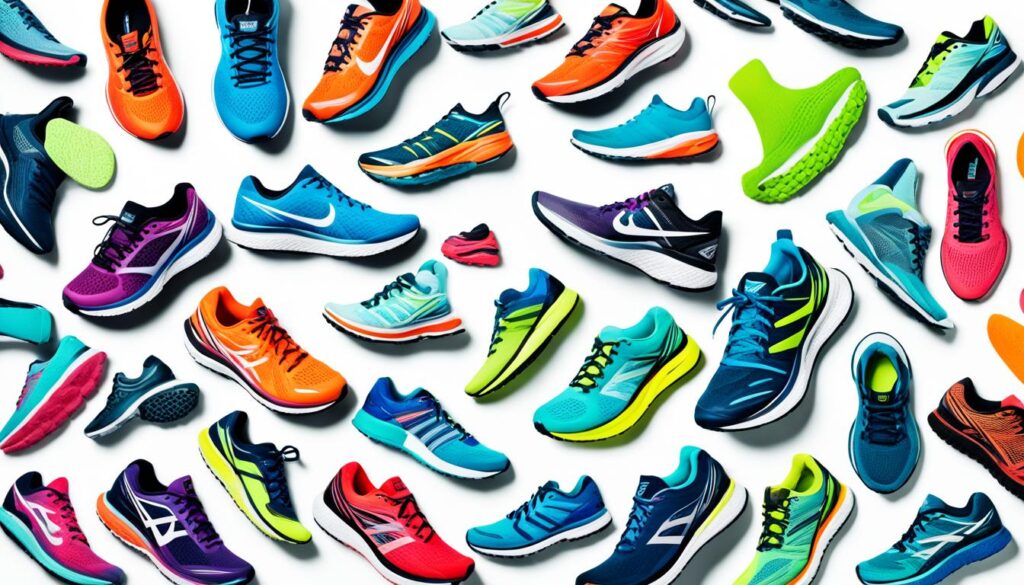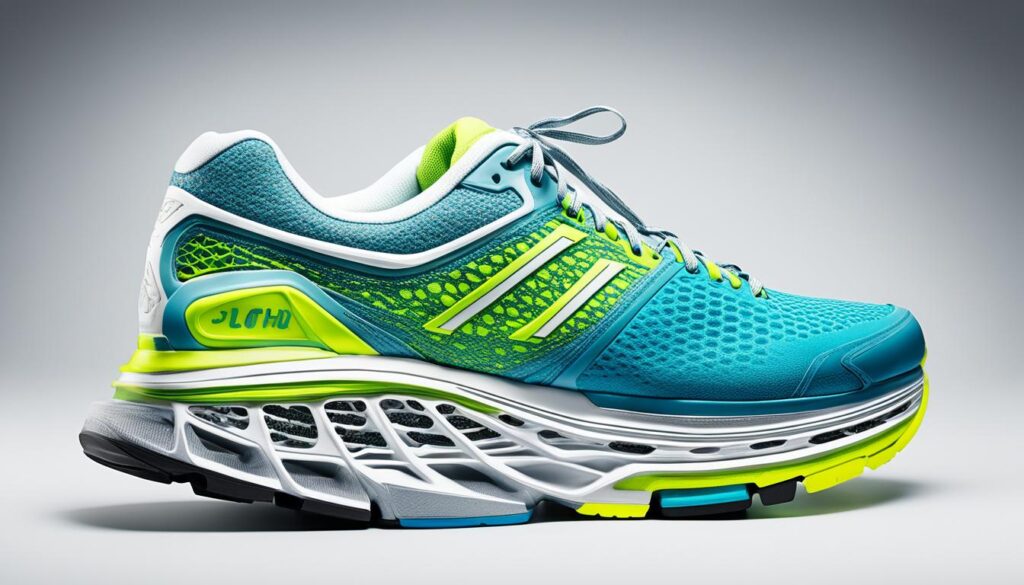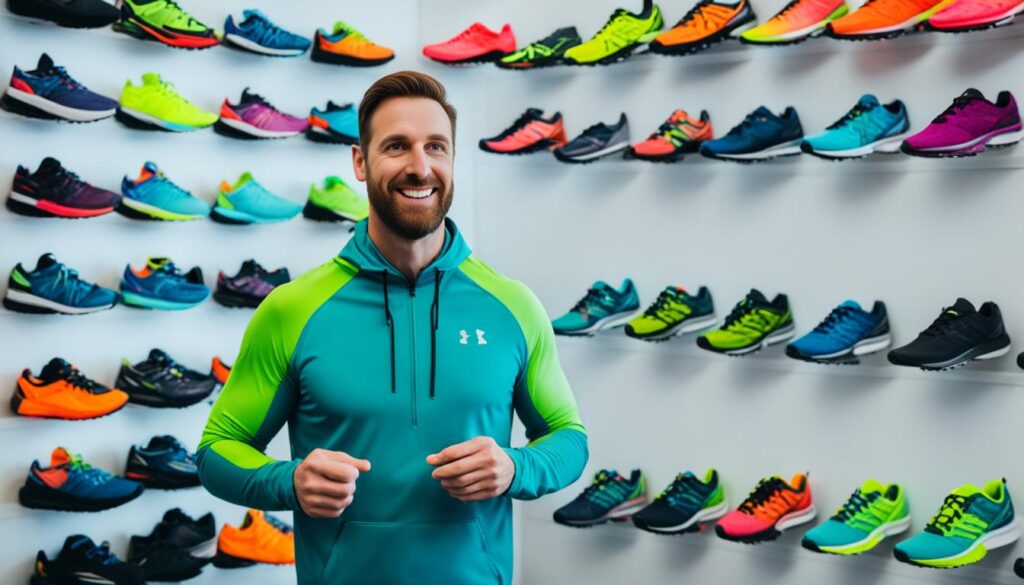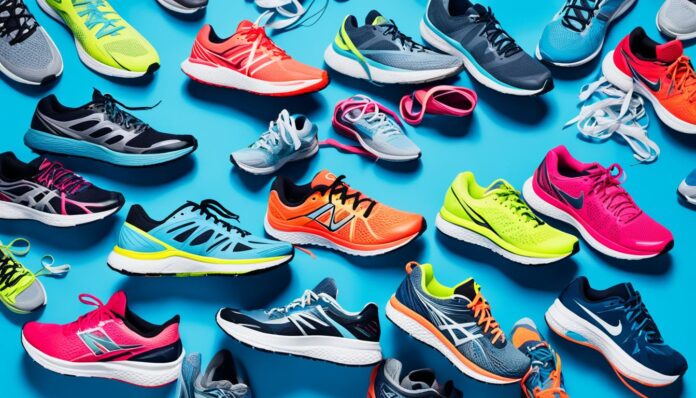Are you tired of lacing up your running shoes only to be met with discomfort, blisters, or aching joints? Finding the perfect pair of running shoes can be a daunting task, with the industry offering a wide variety of choices that make it challenging for consumers to find the best-fitting shoe1. But fear not, this comprehensive guide will equip you with the knowledge and insights to navigate the world of running shoes and ensure you achieve the ultimate in comfort and support.
Key Takeaways
- The running shoe industry offers a diverse selection, making it crucial to find the right fit for your specific needs.
- Many consumers prefer shopping online for running shoes, highlighting the importance of risk-free trial periods to ensure proper fit.
- Shoe brands are utilizing modern technologies like knitting and 3D printing to create seamless uppers for better support and comfort.
- Understanding your foot type and pronation style is essential for selecting the appropriate running shoes.
- Getting a professional fitting at a specialty running store can help you find the perfect shoes for your unique running needs.
Assessing Your Running Needs
When choosing the right running shoes, it’s crucial to consider the specific demands of your running routine. Whether you’re a seasoned runner or just starting, understanding the differences between road and trail running, as well as the distinct requirements for short and long-distance runs, can guide you towards the perfect pair of shoes2.
Surface: Road vs Trail Running
Road running shoes are designed for the consistent, even surfaces of sidewalks and paved roads. They typically feature more cushioning to absorb the impact of each stride2. On the other hand, trail running shoes are built for uneven, off-road terrain. These shoes have larger lugs for better grip, as well as increased protection to safeguard your feet from rocks, roots, and other obstacles2.
Distance: Short Runs vs Long Distances
The distance you plan to run can also influence your shoe selection. Shorter runs, often defined as those under 5 miles, may benefit from a more lightweight, flexible shoe2. However, for longer distances, such as marathon training or ultra-running, a shoe with more cushioning and support can help reduce the impact on your feet and joints2.
Understanding the unique demands of your running surface and distance will help you narrow down the right running shoes for your needs. This, in turn, can enhance your comfort, performance, and reduce the risk of injury23.
Understanding Your Foot Type
When it comes to finding the perfect running shoes, understanding your foot type is crucial. Your foot’s structure and the way it interacts with the ground during your stride can significantly impact the type of running shoe you’ll need for optimal comfort and support4. There are three main foot types to consider: neutral arch, low arch (flat feet), and high arch4.
Pronation: Neutral vs Overpronation vs Underpronation
Pronation refers to the natural inward rolling of your foot as it strikes the ground. Neutral pronation is the ideal scenario, where your foot rolls inward at a moderate and controlled rate4. However, some runners may experience overpronation, where the foot rolls inward excessively, or underpronation (also known as supination), where the foot rolls outward too little4.
Neutral runners with a normal arch can typically benefit from stability shoes, which provide moderate support4. Overpronators with low arches may require motion control shoes to help limit excessive inward rolling and prevent injury4. Conversely, underpronators with high arches may perform best in cushioned shoes that offer ample shock absorption4.
The wear patterns on your current running shoes can also provide clues about your foot type. Even wear across the sole typically indicates a neutral arch, while excessive wear on the inner side of the sole suggests overpronation, and outer sole wear points to underpronation4.
“Understanding your foot type and pronation pattern is essential for finding the right running shoes to support your feet and prevent injury.”
Ultimately, the key is to find a shoe that complements your unique foot structure and running style. With the right information and a professional fitting, you can ensure your running shoes provide the perfect balance of support, cushioning, and stability for a comfortable and injury-free experience56.
Getting a Professional Fitting
Finding the right running shoes isn’t just about aesthetics or brand preference – it’s about ensuring a proper fit that supports your unique gait and prevents injury. Many specialty running stores offer gait analysis and professional fitting services to help you find the perfect running shoes7. Using advanced video technology, experts can assess your running gait and pronation patterns, and then recommend the appropriate shoes based on your individual needs and preferences8.
The fitting process at these specialty stores typically starts with measuring both of your feet while standing up, as there can be a full-size difference between the right and left foot8. The experts will also consider the type of socks you’ll be wearing, as thicker fabric socks may require going up a full shoe size to accommodate8.
Proper running shoe fitting involves ensuring a thumbnail’s width of space between the longest toe and the front of the shoe, considering toe position and width to avoid discomfort8. The experts will also check for lace tightness over the navicular bone, heel slipping, and ensure the upper shoe fabric provides a snug fit without pinching or rubbing against the ankle8.
Ultimately, the goal of a professional fitting is to find the perfect balance between comfort, support, and performance to keep you running strong and injury-free8. By taking the time to get a professional fitting, you can be confident that your new running shoes will provide the best possible fit and function for your unique needs8.
“Trained salespeople at brick-and-mortar shops are more successful in providing a proper shoe fit compared to online purchases.”8
| Foot Width | Women | Men |
|---|---|---|
| Standard | B | D |
| Wide | D | 2E |
| Wider | 2E | 4E |
| Narrow | 2A | N/A |
According to ASICS New Zealand 2019 sales data, the most common shoe width for women in running shoes is D, and for men, it is a 2E7.
Guide to Choosing the Right Running Shoes
Selecting the perfect running shoes is crucial for your comfort, performance, and injury prevention. When navigating the vast array of options, it’s important to consider factors such as your running surface, distance, foot type, and personal preferences. This comprehensive guide will help you make an informed decision and find the running shoes that best suit your needs.
Understand Your Foot Type and Gait
Analyzing your foot type and pronation pattern is the first step in choosing the right running shoes. Neutral, overpronated, or underpronated feet each require specific features to optimize support and stability. Understanding your unique foot mechanics will ensure you select the appropriate level of cushioning and motion control.9
Assess Your Running Needs
Consider the type of running you’ll be doing, whether it’s on the road or trail, and the distances you plan to cover. Road running shoes typically offer more cushioning, while trail shoes provide enhanced traction and protection for uneven terrain. Choosing the right shoe for your running environment and mileage can significantly impact your comfort and performance.9
Prioritize Proper Fit and Sizing
Proper shoe fit is crucial for running comfort and injury prevention. The guide emphasizes the importance of shoe sizing, width, and measurement to ensure a proper fit for running shoes.9 It’s recommended to have your feet measured and try on shoes at the end of the day when they are slightly larger, allowing for natural foot swell during exercise.
Explore Different Shoe Technologies
The material covers various lacing techniques to address common issues such as heel slippage and blisters.9 Additionally, the guide introduces different types of ASICS running shoes, such as the GEL-KAYANO and GT-2000, highlighting their technology, designs, and features to help you choose the best shoe for your running style and training needs9.
Know When to Replace Your Shoes
The guide also points out the significance of knowing when to replace running shoes due to wear and tear that can impact cushioning and stability.9 As a general rule, it’s recommended to replace your running shoes every 300-500 miles or every six months, whichever comes first10.
By following these guidelines and considering your individual needs, you’ll be well on your way to finding the perfect running shoes that will keep you comfortable, supported, and performing at your best.

“The right running shoes can make all the difference in your training and performance. Take the time to find the perfect pair that fits your feet and running style.”
Importance of Proper Shoe Fit
When it comes to running, proper shoe fit is crucial for comfort and injury prevention11. Each foot has 26 bones, making it a biomechanically complex structure that requires the right support and cushioning11. With hundreds of running and trail-running shoes available on the market, finding the perfect fit can be a daunting task, but it’s an essential step in ensuring a comfortable and safe running experience.
Toe Box Space
The toe box, or the area around your toes, should have enough space to allow for natural foot movement and swelling11. Ideally, there should be a thumb’s width of space between your longest toe and the end of the shoe11. A shoe that is too narrow can lead to serious foot problems, such as bunions or hammertoes, while a shoe that is too wide may result in blisters on the ball of the foot11.
Heel Lockdown
A well-fitting shoe should also provide a secure heel lockdown to prevent slippage and reduce the risk of blisters11. Symptoms like tingling or numbness in the toes can indicate insufficient volume or the wrong shoe size, while blisters between or on top of the toes may suggest the shoe is too small11. Bruised toes, on the other hand, could mean the shoes are not long enough, and heel blisters might require lacing techniques like a runner’s loop or a shoe with a narrower heel cup11.
To ensure the best possible fit, it’s recommended to try on shoes at the end of the day when your feet are largest due to swelling11. Additionally, it’s crucial to re-measure your shoe size periodically, as feet can change over time due to various factors11. Each brand has its own proprietary foot model or “last,” which affects the overall fit of the shoe11. Understanding your specific foot issues, such as bunions or hammertoes, and bringing any orthotics you use to the fitting session can also help in finding the right shoe11.
By following these detailed guidelines and considerations, you can set yourself up for a successful shoe fit, both in-store and at home11. The tips provided here will help you find the perfect running shoes that offer the right balance of comfort, support, and performance, reducing the risk of foot and ankle injuries121113.
Types of Running Shoes
When it comes to finding the right running shoes, it’s important to understand the different types available. Running shoes can be categorized based on the level of support and cushioning they provide to cater to various foot types and running needs. Let’s explore the three main categories of running shoes: neutral cushioned shoes, stability shoes, and motion control shoes.
Neutral Cushioned Shoes
Neutral cushioned shoes are designed for runners with a normal degree of pronation, which is the natural inward rolling of the foot during the gait cycle. These shoes provide a balanced level of cushioning and support, allowing the foot to move through its natural range of motion14. Neutral cushioned shoes are a popular choice for the majority of runners, as they offer a comfortable and responsive ride without excessive support or control.
Stability Shoes
Stability shoes are designed for runners who exhibit mild to moderate overpronation, where the foot rolls inward excessively during the gait cycle. These shoes feature additional support and stability features, such as firmer midsole materials or guide rails, to help correct the overpronation and provide a more controlled and stable platform10. Stability shoes are suitable for runners who need a bit more support to maintain proper foot and ankle alignment during their runs.
Motion Control Shoes
Motion control shoes are the most supportive and stable option, designed for runners with severe overpronation or flat feet. These shoes feature a high degree of control and structure, often with a stiffer midsole and a more rigid heel counter to limit excessive inward rolling of the foot10. Motion control shoes are typically recommended for heavier runners or those with significant pronation issues, as they provide the most substantial support and stability.
It’s important to understand your foot type and running gait to select the appropriate shoe category14. Seeking guidance from a qualified running specialist or healthcare professional can help you determine the best type of running shoe for your individual needs and preferences.
| Shoe Type | Foot Type | Key Features |
|---|---|---|
| Neutral Cushioned Shoes | Normal Pronation | Balanced cushioning and support |
| Stability Shoes | Mild to Moderate Overpronation | Added stability and control features |
| Motion Control Shoes | Severe Overpronation, Flat Feet | Highest level of support and structure |
By understanding the different types of running shoes and their intended use, you can make a more informed decision to find the perfect pair that will support your unique running needs and help you achieve a comfortable and efficient stride10.
“The advice provided suggests starting with neutral shoes and only moving to stability shoes if necessary or advised by a healthcare professional.”
Cushioning Levels in Running Shoes
When it comes to running shoes, the level of cushioning can have a significant impact on your comfort and shock absorption. The midsole, which is the primary source of cushioning, often incorporates various foam technologies and materials to deliver the desired level of softness or firmness15. Choosing the right cushioning level can help reduce the impact on your joints and provide a more comfortable ride15.
Running shoes can be categorized into different cushioning levels, ranging from minimalist to maximum cushioning16. Maximum cushion shoes typically have a stack height of 35mm and above, offering a plush and highly cushioned experience16. In contrast, over-cushioned shoes usually have a stack height between 25-35mm, providing a balance between comfort and performance16. Traditional cushion shoes, on the other hand, have a lower stack height, generally less than 25mm, which enhances ground feel and proprioception16.
The cushioning level in running shoes can also influence the overall stability and support16. Shoes with higher stack heights, like maximum cushion shoes, tend to be more supportive due to the additional foam creating a stiffer midsole16. On the other hand, traditional cushion shoes are lighter and more flexible, offering a more natural feel16.
It’s important to note that the cushioning level should be chosen based on your individual needs and preferences17. The stack height, which is the height of the sole between the foot and the ground, can range from minimalist shoes around 15mm to max-cushioned running shoes starting at 30mm and increasing from there17. Most max-cushioned running shoes also have a higher stack height in the heel than the forefoot, emphasizing more padding to cushion the impact of a heel strike17.
While high-cushion shoes may offer a more comfortable ride, it’s crucial to remember that they may not guarantee injury prevention17. Proper running form and individual body feedback are essential factors in choosing the right running shoes, regardless of the cushioning levels17.
| Cushioning Level | Stack Height | Characteristics |
|---|---|---|
| Maximum Cushion | 35mm and above | Highly cushioned, plush ride |
| Over-Cushioned | 25-35mm | Balance of comfort and performance |
| Traditional Cushion | Less than 25mm | Lightweight, flexible, enhanced ground feel |
In summary, the cushioning levels in running shoes can significantly affect your comfort, shock absorption, and overall running experience. By understanding the different cushioning options and choosing the right fit for your individual needs, you can find the perfect running shoes to support your active lifestyle151617.
Midsole Technology and Features
The midsole is a critical component of a running shoe, responsible for providing cushioning, stability, and responsiveness18. Shoe manufacturers employ a variety of technologies and design features in the midsole to optimize the shoe’s performance and support. Understanding these midsole features can help you select the right running shoes for your needs.
One key midsole technology is foam compounds. Running shoes may use different types of foam, such as EVA (Ethylene-Vinyl Acetate), to provide varying levels of cushioning and responsiveness19. Some shoes also feature carbon plates or other propulsion-boosting elements in the midsole to enhance running economy and speed19.
Midsole features like flex grooves and medial posts also play a crucial role in a shoe’s stability and support18. Flex grooves allow the midsole to bend and flex naturally with the foot’s movement, while medial posts provide additional support for runners who overpronate (their feet roll inward excessively).
| Midsole Technology | Description |
|---|---|
| Foam Compounds | Provide cushioning and responsiveness, such as EVA, polyurethane, and more advanced foams. |
| Propulsion Plates | Carbon or other materials that enhance running economy and speed. |
| Flex Grooves | Allow the midsole to bend and flex naturally with the foot’s movement. |
| Medial Posts | Provide additional support for runners who overpronate (feet roll inward excessively). |
It’s important to note that different running shoe brands may use various technologies and features in their midsoles18. For example, some may have additional supportive structures like guide rails or dual-density materials to cater to different degrees of pronation18. Feet can also change over time, necessitating a change in running shoe choice to ensure optimal support and comfort18.

Understanding the midsole technology and features of running shoes is crucial when selecting the right pair for your needs. By considering factors like cushioning, stability, and responsiveness, you can find a shoe that provides the right balance of comfort and performance to support your running goals19.
Outsole Durability and Traction
The outsole of a running shoe is the critical component that comes into direct contact with the ground, providing both traction and durability20. The outsole’s materials and tread patterns are carefully designed to offer the appropriate level of grip and wear resistance for the intended running surface, whether it’s the road or the trail20. Considering the outsole’s characteristics is essential for ensuring your shoes can handle the demands of your running environment and provide the necessary performance20.
For runners seeking maximum outsole durability, options like the Brooks Cascadia or Salomon Speedcross are excellent choices20. These shoes feature rugged, high-abrasion rubber outsoles that can withstand the rigors of trail running and off-road terrain20. Conversely, runners who prioritize road running may prefer shoes with a more flexible, responsive outsole, such as the Asics Gel-Nimbus or Nike Vaporfly, which are designed to provide a smooth, efficient ride on paved surfaces20.
The outsole’s traction is equally important, as it helps prevent slipping and ensure a stable, secure foot plant20. Trail running shoes typically feature aggressive, multi-directional lugs that provide exceptional grip on loose, uneven surfaces, while road running shoes often have a more subtle, low-profile tread pattern that prioritizes smooth transitions and energy efficiency20.
| Shoe Model | Outsole Durability | Outsole Traction |
|---|---|---|
| Brooks Cascadia | High-abrasion rubber for excellent durability | Aggressive, multi-directional lugs for superior grip on trails |
| Salomon Speedcross | Rugged, long-lasting Contragrip outsole | Deep, sticky lugs for outstanding traction on technical terrain |
| Asics Gel-Nimbus | Durable, flexible rubber outsole for road running | Subtle tread pattern for smooth, efficient transitions on pavement |
| Nike Vaporfly | Lightweight, responsive rubber outsole | Low-profile tread for maximum energy return on roads |
Evaluating the outsole’s durability and traction characteristics is crucial when selecting the right running shoes for your specific needs and running environment20. By choosing shoes with the appropriate outsole features, you can maximize your comfort, performance, and the lifespan of your footwear20.
Trying on Running Shoes
When it comes to purchasing the perfect running shoes, trying them on and testing them out in-store is a crucial step. Many specialty running stores offer an in-store treadmill testing experience, allowing you to evaluate the shoes in a controlled environment and ensure they provide the right fit and feel for your running needs2122., This is an essential process to avoid issues like blisters or discomfort during your runs, as the amount of pronation a runner can tolerate varies individually21.
In-Store Treadmill Test
During the in-store treadmill test, you’ll have the opportunity to experience the shoes in action and assess their performance. The treadmill allows you to simulate your running gait and evaluate factors such as cushioning, support, and responsiveness23. This hands-on approach helps you determine if the shoes truly fit your needs and running style, rather than relying solely on online reviews or recommendations22.
To get the most out of the in-store treadmill test, wear the socks you typically use for running and bring along any custom orthotics or insoles you might use23. This ensures the shoes are evaluated with the same conditions you’ll encounter during your regular runs. Take your time and pay attention to how the shoes feel, focusing on factors like arch support, heel stability, and overall comfort23.

The in-store treadmill test is an invaluable tool in the shoe-buying process, as it allows you to make an informed decision and avoid any potential issues down the line2322., By taking the time to try on and test the running shoes, you can ensure you find the perfect pair that will keep your feet comfortable and supported during your runs212322.
Brand Considerations
While the brand of a running shoe may not be the most crucial factor, it can still play a significant role in your selection process24. Different running shoe brands often offer unique fits, technologies, and design philosophies, so it’s worth considering the reputation and features of the brands you’re evaluating to ensure you find a shoe that aligns with your preferences and running style25. Many people tend to choose their running shoes based on looks, popularity, or comfort when trying them on in-store, but the price tag can also influence their decision, with the misconception that the most expensive models are not always the best fit25.
When it comes to brand reputation, some of the most well-known and respected names in the running shoe industry include Nike, Asics, Brooks, Saucony, and Mizuno. These brands have a long history of producing high-quality, innovative running shoes that cater to a wide range of running styles and foot types24. When evaluating different running shoe brands, it’s essential to consider factors such as their commitment to research and development, the performance and durability of their products, and their overall reputation within the running community.
In addition to brand reputation, it’s also worth exploring the specific features and technologies offered by different running shoe brands24. For example, some brands may excel at producing highly cushioned shoes for heel strikers, while others might be known for their lightweight and responsive race shoes designed for forefoot landing25. Understanding the unique strengths and specialties of each brand can help you find the running shoe that best fits your individual needs and preferences.
Ultimately, while the brand of a running shoe is not the sole determining factor, it can provide valuable insights into the fit, feel, and performance of the shoe. By considering the reputation and features of the brands you’re evaluating, you can make a more informed decision and increase your chances of finding the perfect running shoes for your comfort and running style242526.
Replacing Your Running Shoes
As a dedicated runner, it’s crucial to maintain the health and longevity of your running shoes27. The standard lifespan of road running shoes is typically between 300 to 500 miles, or around 500 to 800 kilometers27. Lightweight shoes may have a slightly shorter lifespan, around 250 to 300 miles27. For runners who average 20 miles per week, it’s recommended to replace their shoes every 4 to 6 months27.
The terrain you run on can also impact the lifespan of your shoes27. Shoes tend to last longer when used on the specific surfaces they were designed for, such as roads or trails27. Additionally, your running style can affect the wear and tear on your shoes, as forefoot runners tend to wear out their shoes differently than midfoot or heel strikers27.
It’s important to pay attention to the condition of your running shoes and replace them when necessary27. Signs that it’s time to replace your shoes include new pains, worn-out treads, a tough midsole, a noticeable difference when trying on a new pair, and other major signs of wear and tear27. By staying vigilant and replacing your shoes as needed, you can maintain optimal comfort, support, and prevent potential injuries27.
To extend the lifespan of your running shoes, experts recommend only wearing them for running, undoing and redoing the laces, keeping the shoes clean, and wearing the correct socks27. Additionally, rotating between multiple pairs of shoes can help distribute the wear and tear over time27.
“The key to making your running shoes last longer is to take care of them and replace them when they show signs of significant wear and tear. Investing in high-quality, well-fitting shoes can also help extend their lifespan.”
Remember, replacing your running shoes at the right time is crucial for maintaining optimal comfort, support, and preventing injuries. By paying attention to the condition of your shoes and following the recommended replacement guidelines, you can ensure a smooth and enjoyable running experience.
Customizing Your Running Shoes
Even after finding the right running shoes, you can further customize the fit and feel to better suit your needs28. Adjusting the lacing technique can help secure the shoe to your foot, while adding insoles or orthotics can provide additional support and cushioning29. Experimenting with these customizations can help you achieve the perfect fit and enhance the performance of your running shoes.
Lacing Techniques
29 Alternating lacing techniques and skipping eyelets can enhance the customized fit of a running shoe30. Different types of eyelets used in lacing systems include traditional eyelets, D-ring eyelets for quicker lacing, and multi-hole eyelets for accommodating varying foot widths.
- Parallel Lacing: Beneficial for runners with high arches, as it provides a snug fit around the midfoot.
- Heel Lock Lacing: Helps prevent heel slippage and provides a secure fit around the ankle.
- Criss-Cross Lacing: Distributes pressure evenly across the foot for a customized fit.
Insoles and Orthotics
29 The insole of a shoe, made of cushioned material like low-density foam, provides extra shock absorption and shape30. The arch fill of the midsole and sole under the arch should flex with foot movement while providing adequate support.
29 Foot alignment and arch height significantly impact which running shoe will fit best, with low arches possibly needing stability shoes to prevent overpronation and high arches requiring cushioning for shock absorption. Incorporating custom insoles or orthotics can help address these specific needs and further enhance the comfort and performance of your running shoes.
“Experimenting with lacing techniques and adding insoles or orthotics can help you achieve the perfect fit and feel for your running shoes.”
28Running shoes weighing less than 200 grams are generally designed for racing, while the majority of running shoes usually weigh between 250 and 300 grams28. Men’s and women’s running shoe models are designed to meet specific anatomical differences, with a wide variety of options available in both categories28. Manufacturers are increasingly adopting an ecological approach in the production of running shoes, considering materials, production processes, product longevity, and shoe recycling29. In running shoes, materials used in the upper tend to be lightweight mesh for airflow, while the midsole often consists of foam compounds like ethylene-vinyl acetate (EVA) for cushioning and polyurethane for durability29. Brands and models have different sizing standards; even models within the same brand can fit differently, highlighting the need for personalized recommendations such as through a Perfect Fit Finder29. Racing flats, designed for speed during races, lack support but compensate with lightness for quick foot turnover and are recommended for well-maintained tracks or roads, not uneven trail terrain29. Finding a balance between comfort and proper fit in running shoes is crucial to avoid issues like heel pain, blisters, and injuries, with considerations such as snugness without pain being essential29. Proper support and cushioning in running shoes can help prevent injuries such as stress fractures and ankle sprains, with regular replacement of shoes recommended to maintain support and cushioning levels30. Research indicates that a stiffer heel doesn’t necessarily improve control, but is preferred over more flexible designs30. Slip-lasted shoes provide less control and more absorption, while board-lasted shoes offer greater stability30. Three types of lasting methods for attaching the upper to the sole: Slip Last, Board Last, and Combination Last30. The midsole of a running shoe is typically made of foam compounds, such as EVA (ethylene vinyl acetate), and absorbs impact while flexing at the ball of the foot during toe-off30. Factors determining a good midsole include shock absorbency, heel height for Achilles’ tendon stress reduction, and pronation control features30. The toe box of a shoe should comfortably accommodate the toes to prevent constriction and bruising30. There are four types of shoe lasts based on the shape and curve of the shoe: Curved, Slightly Curved, Straight, and Straight Combination Last.
Conclusion
Choosing the right running shoe guide is essential for maintaining comfort, preventing injuries, and enjoying your runs to the fullest. This comprehensive guide has covered the key factors to consider when selecting running shoe selection, from assessing your needs and understanding your foot type to finding the perfect fit and customizing your shoes31. By following these guidelines, you can ensure that your next pair of running shoes provides the support, cushioning, and performance you need to reach your fitness goals.
Whether you’re a beginner runner or a seasoned veteran, the running shoe comfort you choose can make a significant difference in your overall running experience32. By considering factors such as pronation, cushioning, and terrain, you can find the perfect pair of shoes that cater to your individual needs and preferences31. Additionally, consulting with running specialists or pedorthists can provide valuable insights into foot biomechanics and shoe selection, further enhancing your chances of finding the ideal running shoes31.
Remember, the search for the perfect running shoes is a journey, and it may take some trial and error to find the pair that truly works for you32. With the guidance provided in this comprehensive guide, you can navigate the wide array of options and make an informed decision that will keep you comfortable, injury-free, and motivated to continue your running journey. Happy trails!
FAQ
What factors should I consider when choosing running shoes?
When choosing running shoes, you should consider the surface you’ll be running on, the distances you’ll be running, and your foot type and pronation patterns.
How can I determine my foot type and pronation patterns?
Many specialty running stores offer gait analysis and professional fitting services to help you determine your foot type and pronation patterns, and recommend the appropriate shoes.
What are the different types of running shoes?
Running shoes can be categorized into different types based on the level of support and cushioning they provide, including neutral cushioned shoes, stability shoes, and motion control shoes.
How important is proper shoe fit?
Proper shoe fit is crucial for comfort and injury prevention. The toe box should have enough space, and the heel should be securely locked down to prevent slippage.
How do I determine the right level of cushioning for my running shoes?
The amount of cushioning in a running shoe can have a significant impact on comfort and shock absorption. Choosing the right cushioning level can help reduce the impact on your joints and provide a more comfortable ride.
What features should I look for in the midsole of a running shoe?
The midsole is a critical component of a running shoe, responsible for providing cushioning, stability, and responsiveness. Shoe manufacturers employ a variety of technologies and design features in the midsole to optimize the shoe’s performance and support.
How important is the outsole of a running shoe?
The outsole of a running shoe is the part that comes into direct contact with the ground, providing traction and durability. Considering the outsole’s characteristics is important for ensuring your shoes can handle the demands of your running environment.
Should I try on running shoes before purchasing?
Yes, it’s crucial to try on running shoes and test them out before making a purchase. Many specialty running stores offer in-store treadmill testing, allowing you to experience the shoes in a controlled environment and ensure they provide the right fit and feel for your running needs.
How often should I replace my running shoes?
Running shoes have a limited lifespan, typically lasting between 300-500 miles or 3-4 months of regular use. It’s important to replace your shoes when they start to show signs of wear to maintain optimal comfort and support.
Can I customize my running shoes to get a better fit?
Yes, even after finding the right running shoes, you can further customize the fit and feel to better suit your needs. Adjusting the lacing technique and adding insoles or orthotics can provide additional support and cushioning.
Source Links
- 5 Tips for Buying the Perfect Pair of Running Shoes
- Your Guide to Finding the Right Running Shoes
- Choosing the Right Running Shoes: A Comprehensive Guide | Toolen’s Running Start
- Finding the Right Running Shoe | Orthopedics & Sports Medicine
- Running shoe shopping 101: How to choose the right pair for your running style
- How to Choose the Right Running Shoe FOR YOU!
- Shoe size guide | Choosing the right running shoe | ASICS NZ
- How to Size Running Shoes So You Can Perform at Your Best
- Choosing the Right Running Shoe | ASICS NZ
- What Running Shoes Should I Buy? How To Choose Running Shoes
- How Should Running Shoes Fit? | REI Co-op
- Athletic Shoes: How to Find the Proper Fit
- A Guide To The Importance of a Properly Fitted Running Shoe
- How to Choose the Best Running Shoes for You
- How to Choose Running Shoes: A Comprehensive Guide
- Shoe Cushioning, Explained
- How To Choose the Best Max-Cushion Running Shoe
- Choosing the right running shoe: Neutral or Stability?
- Anatomy of a Running Shoe: Here’s What All Those Technical Terms Actually Mean
- Personalized For Success
- Your ultimate guide to choosing a pair of running shoes
- Lace Up Right: A Guide to Choosing the Perfect Running Shoe
- How to Choose the Right Running Shoes (Online or In-store)
- How To Buy Running Shoes
- The Ultimate [Pain-Free] Guide to Choosing The Right Running Shoes (For Your Unique Foot Shape, Gait Cycle, and Running Goals)
- Running Shoes: How To Choose The Right Shoe For You
- When to Replace Your Running Shoes
- How to choose your running shoes
- Find Your Perfect Fit: Understanding How Running Shoes Should Fit
- How To Buy The Right Running Shoes – Custom Foot Clinic & Orthotic Centre
- Run Like the Wind: Your Guide to Finding the Best Running Shoes
- How to Choose the Right Running Shoes?



